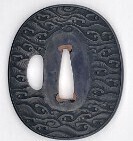I bought this tsuba a while ago, just on impulse because I am a sucker for wave patterns. I am increasingly convinced that it is not an Edo period piece, although I should be clear that I don't think that the shop was in any way dishonest. I should have spent more time looking at it, but that's life. I like the waves, and I am not going to get rid of it. I will keep it around as a reminder to be more careful, and as a reference to look back on.
This is an attempt to illustrate some probable issues with it as a way for other people (like me) to learn from, so please feel free to add your comments on things that I have missed.
The front of the tsuba.
The reverse.
These images show what I have noticed about it that indicate that it is not really a good piece.
The sekigane looks like it is not actually another piece of metal, just a shape in the metal.
These patterns look like they are artefacts from either a casting or stamping process, but I am not entirely sure. The concave shape (see below) makes me think that it was stamped.




